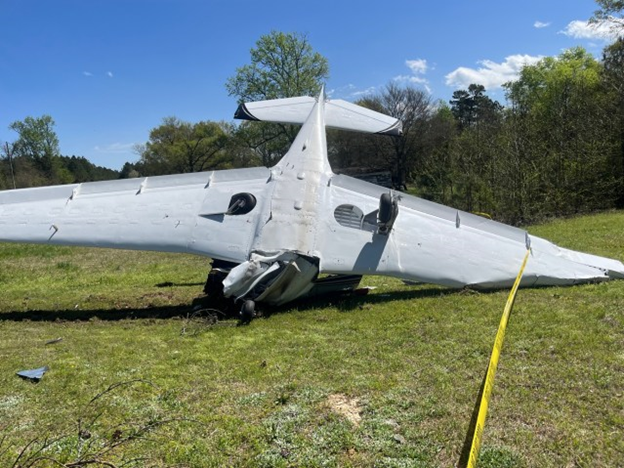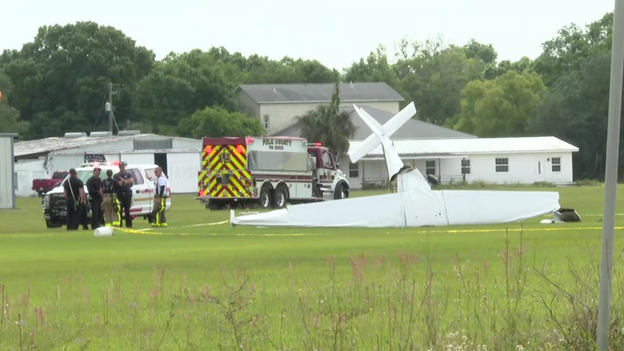Wednesday the 3rd of April, 2024
Published on:
Pilot uninjured after forced landing in Alpine
ALPINE, Arkansas — The pilot of a small aircraft walked away apparently unscathed from a forced landing in rural Clark County on the morning of Tuesday, April 2.
The pilot, from Heber Springs, was en route to Tyler, Texas, flying a 1966 Mooney single-engine fixed wing aircraft when there was an “instant influx of carbon monoxide” into the plane’s cabin that made him feel dizzy, Sheriff Jason Watson confirmed.
The 50-year-old pilot advised air traffic controllers in Memphis that he was maneuvering a forced landing; at that time, Watson said, the pilot shut the engine down to land in a grassy field adjacent to Fendley Road, less than 1/4 mile from its junction with state Highway 8 at Alpine.
The pilot approached the field from the north, apparently maneuvering below a power line to make the landing. In the moments before touching down, however, the aircraft clipped several limbs of a tree, sending it in for a rough landing that, upon impact, folded the engine compartment into the cabin’s exterior. The pilot reportedly was able to escape the wreckage from the cabin door.
Lt. Russell Ursery of the Clark County Sheriff’s Office said the pilot relayed to him that the landing would have been uneventful had it not been for the brush up against the tree limbs.
First responders were dispatched to the scene after a 911 call at 10:58 a.m. The sheriff said the pilot was checked by paramedics at the scene and that he was OK. He was transported by ambulance to Baptist Health Medical Center for further examination. Paramedics had taken the pilot just minutes prior to arkadelphian.com‘s arrival at the scene.
A plane crash is a rare event for the otherwise quiet community of Alpine, which is 5 miles southeast of the town of Amity (population: 681). Randy Palmer, who lives nearby, said he heard the crash from inside his home that sits secluded in a wooded area about 100 yards from the scene. Palmer said he heard a “loud boom” that shook his home. Curious about the noise, he wandered toward Fendley Road and noticed first responder vehicles were lined up along the road.
Police taped off the area immediately surrounding the wreckage. Officials with the Federal Aviation Administration will investigate the crash.
https://arkadelphian.com/2024/04/02/pilot-uninjured-after-forced-landing-in-alpine/


Polk County plane crash kills pilot flying experimental aircraft: ‘Horrible tragedy’
By Carla Bayron and FOX 13 News Staff
MULBERRY, Fla. - A deadly plane crash is under investigation in Polk County.
According to the Polk County Sheriff’s Office, 76-year-old Arthur Canning was killed Tuesday morning when his plane crashed near the South Lakeland Airport in Mulberry.
Polk County Sheriff Grady Judd said Canning had been a pilot for ten years and had been flying ultralights for the past decade.
He added that the plane that went down was a brand-new experimental amateur build, or EAB, that received its certificates last fall.
According to Judd, Canning flew the plane for the first time less than a week ago.
During a press conference on Tuesday afternoon, Judd said Canning taxied down to start and fly into the wind, which is protocol. As he got off the ground, Judd says witnesses told investigators they heard the engine sputter.
"He apparently stalled and crashed directly into the ground," Judd stated. "He immediately died as a result of horrific traumatic injuries from the crash."
Wayne Beyer has been a pilot for 50 years. He said he was standing near the runway when he saw the tragedy unfold. It took around 20 seconds from takeoff to the point of the crash.
"The engine cut off, and then it started a little bit, and it was cut off again and that was it," said Beyer. "I think the wind got it when he tried to turn, or the airplane turned. He should've just kept the nose down straight ahead and landed."
Judd noted that the airfield is a popular grass airstrip that is called the South Lakeland Airport. He said people live adjacent to the airfield and park their planes at their homes.
"It’s a horrible tragedy and certainly not something any of us want to witness," Judd added. "He was up and into the ground in seconds.
PCSO is conducting a death investigation and the NTSB and FAA are investigating the crash.
https://www.fox35orlando.com/news/polk-county-plane-crash-kills-pilot-flying-experimental-aircraft-horrible-tragedy

NTSB Final Report: Pitts Model 12
Pilot Elected To Return To The Airport, And About 1 Minute Later The Engine Sustained A Series Of Power Loss Fluctuations
Location: Conroe, Texas Accident Number: CEN23LA081
Date & Time: January 14, 2023, 14:25 Local Registration: N512P
Aircraft: Pitts Model 12 Aircraft Damage: Substantial
Defining Event: Sys/Comp malf/fail (non-power) Injuries: 1 Serious, 1 Minor
Flight Conducted Under: Part 91: General aviation - Personal
Analysis: The pilot and passenger were conducting a local flight to practice maneuvers and landings. About 3 to 4 minutes after takeoff, and 2,000 ft above ground level, the pilot noticed a master warning light on instrument panel but did not notice any anomalies or problems. The pilot elected to return to the airport, and about 1 minute later the engine sustained a series of power loss fluctuations. The pilot attempted to troubleshoot the problem but was unsuccessful and the engine lost total power. Unable to reach the airport or a field due to a high descent rate, the pilot performed a forced landing to a nearby roadway. During the landing, the airplane impacted a powerline and terrain before coming to rest inverted. The airplane sustained substantial damage to the wings, fuselage, and empennage.
Postaccident examination of the airplane revealed non-ferrous metallic debris throughout the entire fuel system; the source of the debris was unable to be determined. Due to a leak noted during a functional test, the engine-driven fuel pump was disassembled. Scratches and scoring marks were noted on the pressure relief valve seat, which allowed fuel into the air side cavity of the fuel pump. It is likely the fuel pump air cavity filled with fuel, which equalized the pump pressure and restricted fuel flow to the engine. The restricted fuel flow resulted in a total loss of engine power.
Probable Cause and Findings: The National Transportation Safety Board determines the probable cause(s) of this accident to be -- The failure of the engine-driven fuel pump, which resulted in a total loss of engine power. Contributing to the failure of the fuel pump was an unknown non-ferrous metallic debris that was noted throughout the airplane’s fuel system.
FMI: www.ntsb.gov

Today in History
28 Years ago today: On 3 April 1996 a USAF Boeing T-43A (B737) crashed on approach to Dubrovnik, killing all 35 occupants.
Time: 14:57
Type: Boeing T-43A (737-200)
Owner/operator: United States Air Force - USAF
Registration: 73-1149
MSN: 20696/347
Year of manufacture: 1974
Engine model: Pratt & Whitney JT8D-9A
Fatalities: Fatalities: 35 / Occupants: 35
Aircraft damage: Destroyed, written off
Category: Accident
Location: 3 km N of Dubrovnik Airport (DBV) - Croatia
Phase: Approach
Nature: Military
Departure airport: Tuzla International Airport (TZL/LQTZ)
Destination airport: Dubrovnik Airport (DBV/LDDU)
Confidence Rating: Accident investigation report completed and information captured
Narrative:
A United States Air Force Boeing T-43A (USAF designation for the Boeing 737-200) was destroyed after impacting a hillside during an NDB approach to Dubrovnik Airport, Croatia. All 35 on board were killed.
The aircraft was engaged in a mission to fly United States Secretary of Commerce Ron Brown and a delegation of industry executives around the region for visits. The party was to be flown from Zagreb to Tuzla and Dubrovnik before returning to Zagreb.
Operating with a call sign of IFO21, the accident aircraft departed Zagreb at 06:24 hours. The crew landed at Tuzla at 07:15 after an uneventful flight. The passengers deplaned, and the aircraft was then repositioned to Split because of insufficient ramp space at Tuzla to park the aircraft for the duration of the visit.
At 12:47, the aircraft landed at Tuzla, where the passengers reboarded. The accident flight departed Tuzla for Dubrovnik at 13:55. After crossing Split at 14:34 the flight was cleared to descend from FL210 to FL140. Further descent clearance was given to FL100. After the aircraft reached FL100 at 14:45, south of Split VOR, Zagreb Center transferred control to Dubrovnik Approach/Tower.
The controller cleared IFO21 direct to the Kolocep (KLP) NDB. After opposite-direction traffic had been cleared, IFO21 was cleared to descend to 5000 feet. At 14:52, the crew told Dubrovnik Approach/Tower that they were 16 NM from the airport. They were cleared to descend to 4,000 feet and told to report crossing the KLP beacon.
At 14:53, the aircraft crossed KLP, which was the Final Approach Fix (FAF), at 4100 feet and began the approach without approach clearance from Dubrovnik Tower. At that point the aircraft was slightly high and fast and not completely configured for the approach, as it should have been.
At 14:54, the copilot of IFO21 called Dubrovnik Approach/Tower and said, "Were inside the locator, inbound." IFO21 was then cleared for the NDB approach to runway 12. The aircraft tracked a course of 110 degrees after crossing KLP, instead of tracking the published course of 119 degrees. The aircraft maintained this track from KLP to the point of impact. The accident aircraft descended to 2200 feet which was consistent with the published minimum descent altitude of 2150 feet.
At 14:57, the aircraft impacted a rocky mountainside approximately 1.7 NM to the left (northeast) of the extended runway centerline and 1.8 NM north of the approach end of runway 12 at Dubrovnik Airport.
CAUSE: (1) Command failure to comply with directives that required a review of all instrument approach procedures, not approved by the Defense Dept.
(2) Preflight planning errors, combined with errors made during the flight made by the aircrew.
(3) Improper design of the Dubrovnik NDB.


Mailing Address
Subscribe to our newsletter
Contact Us
We will get back to you as soon as possible.
Please try again later.
